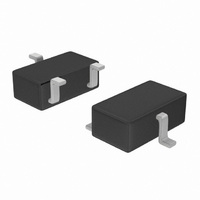XC61HC1612MR-G Torex Semiconductor Ltd, XC61HC1612MR-G Datasheet - Page 5

XC61HC1612MR-G
Manufacturer Part Number
XC61HC1612MR-G
Description
IC SUPERVISOR 1.6V SOT23-3
Manufacturer
Torex Semiconductor Ltd
Type
Simple Reset/Power-On Resetr
Datasheet
1.XC61HC1812MR-G.pdf
(13 pages)
Specifications of XC61HC1612MR-G
Number Of Voltages Monitored
1
Output
Push-Pull, Totem Pole
Reset Timeout
50 ms Minimum
Voltage - Threshold
1.6V
Operating Temperature
-30°C ~ 80°C
Mounting Type
Surface Mount
Package / Case
SOT-23-3, TO-236-3, Micro3™, SSD3, SST3
Lead Free Status / RoHS Status
Lead free / RoHS Compliant
Reset
-
Other names
893-1035-2
■NOTES ON USE
●
2. When a resistor is connected between the V
4. By connecting a resistor between the V
1. Please use this IC within the stated maximum ratings. The IC is liable to malfunction should the ratings be exceeded.
3. When a resistor is connected between the V
5. If a resistor (R
6. Depending on circuit's operation, release delay time of this IC can be widely changed due to upper limits or lower limits
(1) Irregular oscillation as a result of output current with the CMOS output configuration:
(2) Irregular oscillation as a result of shoot-through current:
Irregular Oscillations
and release voltages will rise due to voltage drops at R
may occur as a result of voltage drops at R
added. (refer to Figure 1 below)
supply current flowing through the V
the occurrences of oscillation as described above.
Further, please ensure that R
of operational ambient temperature.
output configurations, oscillation may occur as a result of shoot-through current at the time of voltage release even if
load current (I
Since the XC61H series are CMOS IC
When the voltage applied at IN rises, release operations commence and the detector's output voltage increases.
Irregular oscillation may occur with this "release - detect - release" repetition.
Further, this condition will also appear via means of a similar mechanism during detect operations.
operates (during release and detect operations). Consequently, irregular oscillation is liable to occur during release
voltage operations as a result of output current which is influenced by this shoot-through current (Figure 3).
Since hysteresis exists during detect operations, irregular oscillation is unlikely to occur.
Load current (I
between the input (IN) and the V
a fall in the voltage level at the V
operations will commence. Following detect operations, load current flow will cease and since voltage drop at R
disappear, the voltage level at the V
Figure 1 Use of input resistor R
図 1.入力抵抗を入れた時の回路例
IN
OUT
) must be used, then please use with as small a level of input impedance as possible in order to control
OUT
) does not exist. (refer to Figure 1 below)
XC61HN Series
) will flow through R
IN
is less than 10kΩ and that C
IN
IN
IN
pin, the load current will flow via the IC's V
IN
pin.
pin. When the V
IN
pin will rise and release operations will begin over again.
L
. Because a voltage drop (R
IN
pin and the input, detect and release voltages will rise as a result of the IC's
S
IN
, shoot-through current will flow when the IC's internal circuit switching
IN
IN
if load current (I
pin and the input with CMOS output configurations, irrespective of N-ch
pin and the input with CMOS output configurations, irregular oscillation
IN
IN
brought about by the IC's supply current.
pin voltage level falls below the detect voltage level, detect
OUT
IN
is more than 0.1μF (Figure 1). In such cases, detect
) exists. It is therefore recommend that no resistor be
IN
x I
OUT
) is produced at the R
IN
pin. The voltage drop will also lead to
XC61HC Series
IN
resistor, located
XC61H
IN
Series
will
5/13













